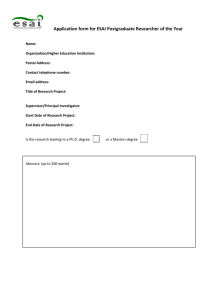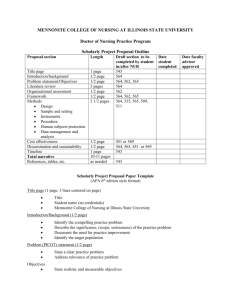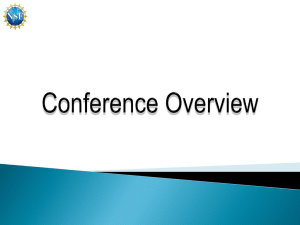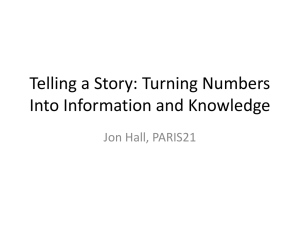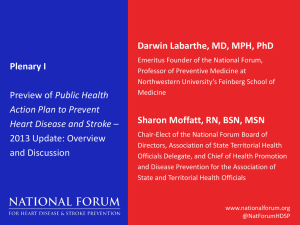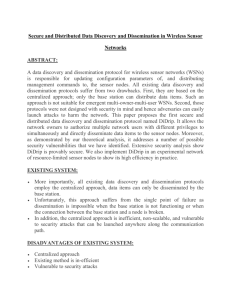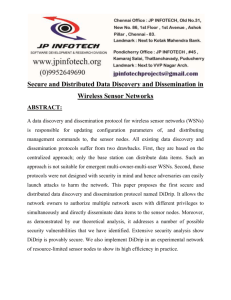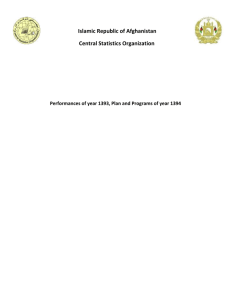Deconstructing Dissemination
advertisement
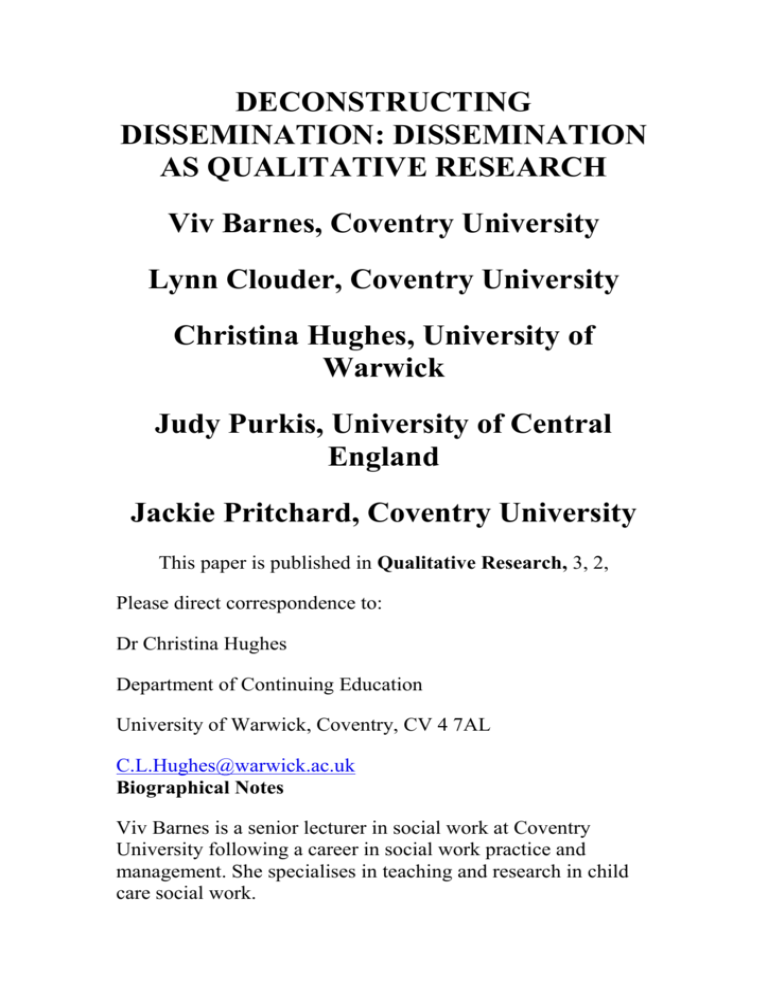
DECONSTRUCTING DISSEMINATION: DISSEMINATION AS QUALITATIVE RESEARCH Viv Barnes, Coventry University Lynn Clouder, Coventry University Christina Hughes, University of Warwick Judy Purkis, University of Central England Jackie Pritchard, Coventry University This paper is published in Qualitative Research, 3, 2, Please direct correspondence to: Dr Christina Hughes Department of Continuing Education University of Warwick, Coventry, CV 4 7AL C.L.Hughes@warwick.ac.uk Biographical Notes Viv Barnes is a senior lecturer in social work at Coventry University following a career in social work practice and management. She specialises in teaching and research in child care social work. Lynn Clouder is a Senior Lecturer in Health and Social Sciences at Coventry University. She has published widely on reflective practice and recently completed her PhD An Exploration of the Social Construction of Professional Identities at the University of Warwick. Christina Hughes is a senior lecturer in the Department of Sociology, University of Warwick. Her recent publications include Women's Contemporary Lives: Within and Beyond the Mirror (2002, London, Routledge) and Key Concepts in Feminist Theory and Research (2002, London, Sage). She is currently completing an edited text on dissemination (Disseminating Qualitative Research in Educational Settings, Buckingham, Open University). Jackie Pritchard is a Principal Lecturer in Nursing Studies at Coventry University. For many years she was the course leader to the Health Visitor Course and is currently teaching on a wide variety of post-registration nursing and midwifery programmes with a particular concern for research methods and communication skills. Jackie completed her PhD Public, Private and Personal: A Qualitative Study of the Invisible Aspects of Health Visiting, University of Warwick, in 2001. Judy Purkis is a senior lecturer in Women's Health Studies at the University of Central England. She is a registered nurse and midwife and after a first degree in Health and Social Policy undertook a Master's degree in Continuing Education. She is currently undertaking research on the experiences and retention of newly qualified midwives for for her PhD. DECONSTRUCTING DISSEMINATION: DISSEMINATION AS QUALITATIVE RESEARCH Abstract This paper offers a critique of dissemination models that are based on technical rationalist ontologies. We argue that such models privilege a particularly narrow set of meanings and in consequence preclude other ways through which we might imagine dissemination acts. Our paper therefore seeks to deconstruct dissemination in order to illuminate the ethical, political and communicative issues that lie at the heart of dissemination practices and to offer a range of alternative ways that dissemination might be conceptualised. These issues are illustrated through a series of vignettes that are drawn from research in the fields of education, health and social care. These focus on the everyday features of qualitative research that are more usually discussed in relation to substantive issues of methodology rather than dissemination per se. These vignettes are designed to demonstrate how dissemination is present at the very moment of conceptualising research and that it continues in ways we have yet to explore well after the formal stages of research are complete. Key Words Dissemination, deconstruction, evidence-based research, postmodernism, poststructuralism Introduction The discourses of `end users', `evidence informed' research, `quality', `value for money', `policy relevance' `best practice' and `research impact', together with the audit culture of higher education research, suggest that a high profile would be given to an analysis of academic experiences of dissemination. Indeed, a key word search of the database on the social science gateway SOSIG highlights the extent to which dissemination is perceived to be a core activity of research and academic life. This search indicated that 132 organisations include the concept in their policy statements. A search of the ESRC data base REGARD drew 88 items. Nevertheless, these references were a descriptive note about dissemination approaches rather than an analysis of academic practices of dissemination. A similar search of research methods textbooks indicates how the topic of dissemination has not received any sustained analysis or critique. Indeed, even those texts that are concerned with action research where dissemination is integral to the process give it scant mention (see for example, Hart and Bond, 1995; Greenwood and Levin, 1998; Morton-Cooper, 2000). Where dissemination is discussed, the primary responses are to treat it as the final stage of research. Thus, `how to' texts, such as Blaxter, Hughes and Tight (2001) include a short section on dissemination in terms of the end-product of research. Texts such as Robson (2000) discuss the implementation of evaluative findings in terms of a written report. Within the broader social science research literature issues of dissemination appear to vary across the disciplines. For example, Stokking (1994) argues that the links between research knowledge and working practices are particularly strong in areas such as health care, agriculture and industry. In consequence, this has led to greater systematisation in the dissemination of research. Within both school and continuing education research, however, dissemination has been seen as particularly problematic (see for example Schuller, 1996; Hillage et al 1998). Indeed Hillage et al (1998) identified `rampant ad-hocery' as the main approach to dissemination in school based research. In addition, it would be fair to say that the predominant understandings of dissemination focus on technical-rational models that are based on positivist understandings of social reality. For example, Freemantle et al (1994: 133) refer to dissemination as the process of implementation through which users `become aware of, receive, accept and utilise information'. Such models are presented through check-list approaches, stages and `good practice' guides. In contrast our own approach to understanding the processes of dissemination has focused on a deconstructive model that has sought to illuminate the ethical, political and communicative issues that lie at the heart of dissemination practices. Spivak (1999: 423) notes how deconstruction is a term coined by Jacques Derrida whose early writings `examined how texts of philosophy, when they established definitions as starting points, did not attend to the fact that all such gestures involved setting each defined item off from all that it was not'. Thus whilst a definition attempts to offer a fixed and indeed closed meaning this meaning is actually drawn from an absent other. For example, Table 1 sets out some of the main meanings of dissemination in the left hand column. However, the meanings in the left hand column draw on those from those listed on the right. The predominant meanings of dissemination that we have outlined above therefore invoke the trace or mark of those meanings in the right hand column. Table 1 about here In addition this relational nature of meaning gives rise to an instability of meaning. Thus, `the first term in a binary opposition can never be completely stable or secure, since it is dependent on that which is excluded' (Finlayson, 1999: 64). As the main meanings of dissemination change then so do the meanings of what dissemination is not. For these reasons deconstruction sees social life as a series of texts that can be read in a variety of ways and which in consequence give rise to a range of meanings. Moreover, each reading produces another text to the extent that we can view the social world as the emanations of a whole array of intertextual weavings. This is an important point in terms of how we might think about political challenges to meaning as it draws attention to the potential of change rather than stasis. Whilst there is this variety, these binaries are organised in terms of a hierarchy. Thus as we have also indicated the meanings in the left hand column are ascendant. Deconstruction does not seek to overturn the binary through a reversal of dominance. This would simply maintain hierarchization. Deconstruction is concerned to illustrate how language is used to frame meaning. Politically its purpose is to lead to `an appreciation of hierarchy as illusion sustained by power. It may be a necessary illusion, at our stage in history. We do not know. But there is no rational warrant for assuming that other imaginary structures would not be possible' (Boyne, 1990: 124). • To achieve this deconstruction involves three phases (Grosz, 1990). The first two of these are the reversal and displacement of the hierarchy. In terms of reversal we might, for example, seek to reclaim the terms on the right of Table 1 for more positive interpretations of their meanings in relation to dissemination. However it is insufficient simply to try reverse the hierarchical status of any binary. At best this simply keeps hierarchical organisation in place. At worst such attempts will be ignored because the dominant meanings of a hierarchical pairing are so strongly in place. This is why it is necessary to displace common hierarchized meanings. This is achieved by displacing the `negative term, moving it from its oppositional role into the very heart of the dominant term' (Grosz, 1990: 97). The purpose of this is to make clear how the subordinated term is subordinated. This requires a third phase. This is the creation of a new term. Grosz notes that Derrida called the new term a `hinge' word. She offers the following examples: • ... such as `trace' (simultaneously present and absent), `supplement' (simultaneously plenitude and excess); `différance' (sameness and difference); `pharmakon' (simultaneously poison and cure); `hymen' (simultaneously virgin and bride, rupture and totality), etc. ... These `hinge words' (in Irigaray, the two lips, fluidity, maternal desire, a genealogy of women, in Kristeva, semanalysis, the semiotic, polyphony, etc) function as undecidable, vacillating between two oppositional terms, occupying the ground of their `excluded middle'. If strategically harnessed, these terms rupture the systems from which they `originate' and in which they function. (p 97) A primary purpose of our paper is to use the dualistic framing of dissemination to illustrate that the subordinate side of the binary is worthy of exploration. In this our paper is focused on the second stage of deconstruction that Grosz (op cit) has set out. Thus we are working at reversing and displacing, but not replacing, predominant meanings. To achieve this our paper is concerned to illustrate how the everyday processes of qualitative research can be reconfigured as dissemination. Our paper is therefore organised in terms of a series of vignettes that draw on our joint and individual experiences of fieldwork across the fields of education, health and social care. These focus on a particular stage or process in the execution of qualitative research and our aim is to highlight how issues of dissemination are embedded within each of them. The Literature Review and Research Design as Dissemination The literature review is an important starting point for the development of knowledge. Commonly the literature review enables students and researchers to acquire an understanding of what has already been accomplished and what the key issues are within a specific field of enquiry. Protocols for conducting literature reviews focus on encouraging systematic, evaluative appraisals of an existing body of work and one of their aims is to encourage the development of expertise in that area (Hart, 1998). In consequence the literature review also forms a key aspects of the design of any piece of research as the results of the review are incorporated into who and what will be studied, what strategies of enquiry and methods will be used for collecting and analysing empirical materials (Punch, 1998). These starting points in the development of a research project are, however, less commonly understood as an aspect of the dissemination process. Rather, dissemination is seen as the endpoint of a linear research design rather than the beginning of another's, or one's own, project. Here, we seek to explore the dissemination of ideas that the literature review represents. A key disseminated idea for those working within critical research paradigms, and one that would be found when undertaking an initial literature review in this field, is that of subverting traditional hierarchical relations. For example, Griffiths (1998: 177) comments that `the terms `power' and `empowerment' crop up a great deal in research related to social justice'. Thus, working within a participatory action research framework Slim and Thompson (1993) argue for the reversal of common expertnovice relations between development workers and those who should be benefiting from this work. Such a principle would be embedded in the research design and would inform the approach taken by researchers in terms of their everyday relations with those whom they perceive their work might benefit or be of use. This principle was formative in the design of the research we outline here and concerned with women's experiences of childbirth. The researcher, who was also a midwife, was particularly concerned with how the authority of medical knowledge, embodied through midwives and doctors, created a framework of power that acted to delegitimise any claims to knowledge about birth processes that mothers may possess. For example, medical convention prescribes certain stages in the birth process when mothers should, and should not, `push'. Often these stages are countervailing to what may be described as women's natural inclinations in birthing. Yet the power of medical discourses, and their associated practices, is such that women often give up their `bodily' knowledge in favour of these authorities. Simply put, despite powerful urges to `push', women resist because they are told by authority figures that it is not the `right' time. This observation raises many issues about the inscribing effects of dominant discourses, how certain knowledges become privileged and how one can learn that these work to deny the knowledge that arises through experiences of the most intense and emotional kind. As a midwife undertaking research in this field, the researcher was therefore concerned to avoid replicating such power relations in the conduct of her study. Indeed, as the following field-notes indicate, in this she achieved some success: • A focus group was organised and this comprised of women about to have their first child or second child, a woman, Karen, who already had two children and a midwife, Kara. The researcher was also a midwife. The researcher had assumed that as those with professional experience, she and Kara, the other midwife in the group, would be seen as more authoritative about childbirth. Indeed, the researcher took steps to avoid replicating these common power relations of professional and mother within the group. Indeed, the group dynamic seemed to recognise Karen, the most experienced mother present, as the authority on matters of childbirth. Though occasionally both Kara and the researcher were approached for technical information, more questions were directed to Karen. The researcher's ethical and political stance in the design of her fieldwork was influenced by a concern that she should not use her professional knowledge in order to gain power over those involved in her research. The focus group was organised as an informal occasion. Food and drink were available and the researcher endeavoured to create an atmosphere for the sharing of knowledge and experience. Such a stance may not have been an option had there not been an established stream of methodological writings that engage in such critical approaches. Certainly the researcher, who was at that time a student undertaking an MA dissertation, would not have had the confidence to engage in a research model that did not have some legitimacy in terms of adequate and prior publications that could be systematically accessed and critically appraised at the literature review stage. In addition this instance of fieldwork demonstrates a countervailing understanding of who has authoritative knowledge about childbirth wherein the expected `authority' that of the professional - was disrupted and where personal and private knowledge was recognized as equally, if not more, authoritative. Here the boundaries of power are reordered but, importantly for what we have to say in the conclusion, they are not overcome. In this instance the experienced mother becomes the expert because, we would argue, in some contexts direct experience is a more valued form of knowledge. As an example of dissemination, this vignette therefore also demonstrates how particular kinds of knowledge are valued and taken-up in the everyday discussions that occur between participants in particular knowledge communities and indeed, in this case, amongst and by the researched. It is to the place of the researched in the dissemination of ideas that we now turn. Interviewing as Dissemination As advocates of reflexive methodology, Alvesson and Skoldberg (2000:5) argue that `empirical research in a reflective mode starts from a sceptical approach to what appears at a superficial glance as unproblematic replicas of the way reality functions'. From this perspective, rather than being conceived of as a conclusive, formal and highly controlled phase of research the reality of dissemination might be more appropriately acknowledged as somewhat less conclusive, informal and rather more difficult to control than we might want to believe. Reflexivity means that `serious attention is paid to the way different kinds of linguistic, social, political and theoretical elements are woven together in the process of knowledge development, during which empirical material is constructed, interpreted and written' (Alvesson and Skoldberg, 2000: 5). As a consequence we want to highlight here how reflexivity is inherent in how we might reconfigure dissemination. In particular, reflexivity requires us to pay as much attention to issues of process as we might pay to the end products of dissemination. Thus, through a reflexive approach we have become aware of the ways in which everyday processes of qualitative research, such as conducting fieldwork, might involve dissemination. For example, here we consider how the research interview becomes a joint construction between parties with the researcher as much involved in knowledge creation as the interviewee (Collins, 1998). Thus the following excerpt taken from a longitudinal study concerned with the professional socialisation of occupational therapy students illustrates how ideas and reflections are shared in a dialogical research relationship: Researcher: You must be wearing yourself into the ground trying to run around after the family and cope with the course. Student: I guess I am really but it's not for much longer. It'll be easier once my placement is over because I'm often not home until late. Researcher: But isn't next term going to be heavy? Student: Yes, I suppose so. I've got my project to get on with and things aren't too good at home. My daughter's not getting on too well with her Dad and she's not a hundred percent well ... but ... Researcher: But how about you? Perhaps you need to think about yourself a bit more. That's not being selfish ... caring is about learning to care about you as well as everyone else ... it's getting a balance. You can't be there fore everyone all of the time. Student: You're probably right but it's not easy. We are familiar with the critiques of such an interaction from those colleagues who adhere to scientific models of interviewing that are based on principles of detachment and rationality. Here concerns would be raised about interviewer involvement contaminating the data, reducing validity and therefore compromising the integrity of the research process. This has led to an emphasis on endogenous reflexivity where engagement in introspection is a means of enabling the researcher to make transparent their role in the construction of meanings (Hughes, 1999). This might, for example, be through first-hand, confessional accounts of the research process. However, less acknowledged is the role of reflexivity on the part of research participants. Thus, we might ask "What kinds of ideas are disseminated during the research interview and how are they taken up?" This is illustrated in an interview with the same respondent conducted several months later: Student: I could spend every waking hour on the course but it's about balance as well. As a family we've had our ups and downs but in a lot of ways I think it's [the course] really helped. It's improved the relationship between my husband and myself. It's enhanced family life in some respects. Sometimes I feel guilty. My daughter's got problems but they're her problems ... not mine. I can help and advise when I'm there. I think I've probably grown a lot. This excerpt illustrates how the interviewee's attitude towards her role within the family had developed over the period between interviews. While other influences may have played a part in this change in attitude, this conversation brought with it the realisation that developing ideas had been shared (disseminated) albeit quite unintentionally, out of honest concern for someone struggling to cope. It is probable that such dissemination, if we are to name it as such, is ubiquitous and ongoing in much qualitative research. At times it may be intentional and at other times totally unintentional. As we have seen in the first vignette outlined in this paper that was concerned with research into women's experiences of childbirth, this ongoing conversation may be conducted with those who originally participated in the research through formal interviews. It may occur through chance meetings when one is asked "How is the research going?". It may be conducted with a range of significant others, including research supervisors, colleagues and future students. The products of research may well inform teaching and become disseminated in classrooms and in ongoing practice. In such cases dissemination becomes on ongoing conversation that one has throughout one's research and teaching career. It is certainly a conversation that one has in respect of the appropriate analysis of empirical data and it is with this in mind that we now consider the development of analytic frameworks as dissemination. The Analytic Framework as Dissemination Early in the research process the researcher takes numerous decisions that will influence the nature, content and outcomes of research. The personal and political nature of these analytical decisions has led Marshall and Rossman (1995: 113) to describe the interpretative act as `mysterious in both qualitative and quantitative analysis'. In addition, they argue that the multiple and diverse nature of social reality means that there are always a range of explanations to be considered. Similarly, Coffey and Atkinson (1996) explore the variety of ways through which data can be managed and analysed in order to enrich understandings of complex situations. It is clear, therefore, that the choice of analytic framework will influence the interpretation and the nature of findings for dissemination. Dissemination issues then become significant throughout the processes of research analysis. One of the metaphors used to convey the multiple choices of analytic framework is that of a lens through which we view the data. Williams (1990) and Barr (1999) use the term lens as a way of conveying the reflexive processes they undertook when re-visiting past research experiences. Other uses of lens have been as a process of orientation (Patton, 1990), as an organising principle (Delamont, 1992), as an entrance into transcripts (McCracken, 1988) and as a focus through narrratives to practice (Lewis, 1993). Each of these uses imply that a particular lens has been a deliberate choice and analysis and outcomes could have been otherwise. Clearly, therefore, this also means that the resulting findings need to be contextualised within the analytic framework selected by the researcher. The issue of multiple ways through which data can be analysed and, in consequence, its impact on dissemination, is illustrated here through a qualitative study with health visitors conducted by one of us (Pritchard, 2001). An important issue facing health visitors is the extent to which they use their personal experience in their professional practice. Health visitor training and professional codes of conduct stress the importance of detachment and the use of systematic evidence as the basis of practice. Invoking personal experiences of childcare and childrearing is seen to be both illegitimate and poor practice. This study therefore explored the tensions that exist between a scientific and an experience base to health visiting. The methodology included semi-structured interviews with thirtyfive health visitors and it sought data on professional and personal changes in relation to health visitors' work with mothers. Nevertheless, the analysis of data raises a number of dilemmas as the researcher, having put questions in a particular way, must then interpret and extend her authority in the way the data is reported and disseminated. This means that the researcher is making choices in emphasis and debate. The following extract illustrates something of the dilemma that health visitors face when situated within the binary of personal and professional. How might this be analysed? • Unfortunately you have to make a distinction between feeling as you would - as any mother would, and then as a professional. Only last week I had to make that distinction, "Where does support start and end?" and then your own responsibility, where your own feelings come into play and then when you're a professional. It's boundaries. It's talking about your own emotions, isn't it? And where they begin and stop. But then of course you've got your standards that you adhere to, that protect against all that, Child Protection Guidelines ... and so on. (Health Visitor) There are clearly a range of interpretations that could be used. For example, in the current climate of managerialism an analytic lens that was concerned with organisational management could have used this extract to evaluate protocols and the efficacy of easily identified work components as a means of withstanding the private and personal experiences of the worker. The resulting dissemination might then focus on, say, the managerial issues of developing or enhancing policy guidelines that are designed to sustain a clear demarcation between these spheres of life. Alternatively, a feminist lens that was concerned with the political effects of such public/private segregation would, as indeed it did, focus on the systematic devaluing of the personal and how this, in corollary, enhances the status of the medical model of health visitor training and practice. We raise this issue because a key concern of those critical of evidence based paradigms is that research can become decontextualised and presented as universal. For example, the primary purposes of evidence based systematic reviews are to answer questions `such as what works, how things work, what is current practice, how practice or policy has changed over time, and how to assess policy and practice' (http://eppi.ioe.ac.uk/ED/Handbook/HB3.2htm). In this way a meta-analysis of previously published research is produced that is designed to inform the development of practice, policy or a field of study. Working in the field of health, Robinson (1998) is critical of systematic reviews that take insufficient account of the constructed nature of research. Specifically, Robinson argues that overly rigid adherence to guidelines for National Health Service systematic reviews underplays the range of complex situations that exist within multiple and diverse health care practices. In so doing she challenges the external authority that seeks precision in analytical comparison across research on the same subject. By drawing attention to the role of the researcher in selecting an appropriate analytic framework we would support Robinson's challenge and argue that dissemination models need to readjust their focus on the universal and recognise unique, specific and contextualised meanings in the construction of knowledge. Presenting Findings as Dissemination Action research is a model that formalises dissemination to participants during the course of the research process and is often regarded as a tool to bring theory, in the form of disseminated evidence, and practice closer together. Writers on the subject describe a range of cyclical models (Kemmis and McTaggart, 1988; Elliot, 1991; Hart and Bond, 1995) which emphasise the potential of action research to be a responsive, participative process. Ongoing feedback is seen as allowing for collaboration with participants in a way that can bridge the old positivist divide between creators of knowledge, ie researchers, and providers of data, ie the researched. Yet underlying this model is a technical-rational assumption suggesting that there is a knowable social reality `out there' so to speak that can to inform practice. Further, in spite of the collaboration inherent in action research, the researcher may assume that she still has authority over the data produced and also over the dissemination process. The research reported here illustrates how these assumptions and this authority can be disrupted in several ways. This was an evaluation of a new project that had been set up to support young people leaving local authority care. The research was designed on action research principles to give feedback to the Aftercare Project workers at regular intervals so that they could adapt their day to day strategies and longer term business plans in line with findings. Integral to the design was consultation with some of the young people who had been involved in this project and focus group and semi-structured interviews were employed to enable users of the service to express their views as fully as possible. The following excerpt from field notes arose as part of this ongoing dissemination. A meeting was held with the Aftercare Project workers in order to share with them some of the early data from focus groups with the young people and social workers involved in the leaving care process: • Before the meeting [with Aftercare Project workers] K and I went through the focus groups tapes and agreed what we thought were the main points to feed back to the project ... [At the meeting] we got half way through the list and K looked at me. I knew what she meant. The looked so miserable that we had to stop. And I'd thought we had reported lots of positive things. (Excerpt from field notes) The research findings had seemed a reasonable balance of positive and negative issues but clearly the shocked reaction from the Aftercare Project workers illustrated that there was a marked difference in the interpretation of findings. Overwhelmingly they took a negative interpretation of the data presented to them. In this way the researcher's assumed authority over the data and its meaning was called into question. This excerpt highlights the researcher's lack of control over the interpretation of research data and the dissemination process. Although selection of the content of the feedback was dependent on the researchers' interpretation of what was significant in the data, `significance' and `relevance' are not inherent in the data itself (Flick, 1998: 30). Interpretations of research rely on the meanings attributed by the reader or listener and further the meanings attributed can be a matter of personal and political context (Scheurich, 1997). In this case workers may have been particularly sensitised to any negative feature of the findings since these could have led to cuts in funding their project. Further assumptions about the dissemination process are highlighted by this example from action research. Feedback of interim findings to the project workers raised dilemmas about disseminating only a part of the picture during a research project. This is necessarily the case in action research where dissemination occurs at intervals before all data is collected and analysed. Some commentators argue that a partial picture may be misleading in the short term. Thus `Evaluation should be holistic rather than fragmented, presenting a complete picture' (Dullea and Mullender, 1999: 95). This argument rests on an assumption that research can be complete and that we can produce anything other than a partial picture independent of individual perspective and selectivity. Our experience challenges this assumption and raises questions about research findings as a finished product, rather than as a partial and snapshot view of the world. We would argue that `completion' of research and the boundaries of data collection are defined by the researcher. In summary, this example of dissemination as a process through action research illustrates many of the dilemmas inherent in considering quality of evidence for practice. It highlights the differences in interpretation of data that question the authority of the research account as well as questioning the possibility of achieving a complete picture in research. In foregrounding this subordinate side of the binaries of dissemination, those of partiality and lack of authority, we would hope to promote an awareness that dissemination is not an exact science and needs to incorporate an awareness of such uncertainties. The Journal Paper as Dissemination Post-structuralism has presented a number of major challenges to social science research. Through the term the `linguistic turn' these challenges have highlighted how realities are constructed through language and how language shapes how we come to know. This is not in any unproblematic way. Rather language conveys a range of meanings that are never fixed or static. Meanings are not only ambiguously shared in the everyday. Researchers also shape meanings in the presentation of their findings. The previous vignette demonstrates one aspect of this where the researchers were concerned that they would present `positive' findings to their end-users. Certainly Atkinson (1990) illustrates how the believability of the research report is not a given that just comes with the data. It is formed through the researcher's use of a variety of literary devices and narrative strategies that depict rhetorical figures, use descriptive vocabulary to evoke the scenes within which these characters live their lives and which rely on the selection of appropriate illustrative material. Nevertheless, as we have also seen above, authorial authority is never guaranteed. Post-structuralism also challenges the idea that there exists `a single, literal reading of a textual object, the one intended by the author' (Barone, 1995: 65). Although some readings are more privileged than others interpretation cannot be controlled. Readers bring their own knowledges, experiences, values and meanings to the text. As Smith (1998: 260) notes: • Post-structuralist discourse analysis undermines the idea that language is a transmission device for carrying the intention of the author, with the reader trusting an authoritative voice. If the author is no longer the authoritative voice of truth and authenticity, readers can be seen as participating in the production of meaning by constructing their own stories. This final vignette draws on this understanding of meaning within post-structural theorisation and focuses on reviewer responses to a paper submitted to a journal for publication. A key idea in the dissemination of knowledge is that of the gatekeeper. The gatekeeper is viewed as someone who will facilitate or deny access and in so doing gatekeepers represent important figures in the flow of ideas. Commonly, our understandings of gatekeepers' practices are limited to first-hand or confessional accounts of research practices. Less known is the gatekeeping practices of journal editors and their associated reviewers. In addition, our understandings of these practices fall into a binaried template of being allowed in or being kept out. An article is either published or it is not. In practice, however, the responses of gatekeepers may be contradictory or conflictual and as a result access may be partial or staged as the paper goes through a number of revisions. The following are comments received from reviewers in relation to a paper that used sociological `poems' (Richardson, 1992) to convey the multiple positions taken up by women managers in further education colleges in England. As the comments indicate the reviewers disagreed on some fundamental points with respect to the article. Reviewer `A', for example, appeared to approve of the style of the paper whilst Reviewer B did not: • Reviewer A Commented: This is a confident and well written article, which steps lightly across some well trodden epistemological territory. The poems are delightful and evoke `Sylvia' in a most thought provoking manner. Reviewer B Commented: The opening is very vague. As a challenge to conventional knowledge systems, there is a point to this, but the overly metaphorical nature of the writing seems to me to be a means of avoiding being specific with the theory ... the poetry seems to me an unnecessary distraction, poorly informed and unskilled in its execution. One might assume that reviewers for a journal are drawn from similar communities of practice and in consequence have shared assumptions and value frameworks. Weiner's (1998) analysis from research that looked at the practices of journals in education, psychology and sociology certainly suggests some degree of consensus at the level of everyday cultural practices. These included roles and responsibilities of editors and editorial boards, how referees were chosen and the criteria for assessment of manuscripts. However, a further analysis of the reviewers' comments would suggest that the frames of reference of these particular reviewers were quite different. For example, Reviewer B appeared to have read the pseudonym `Sylvia' that was used for one of the women managers referred to in the paper as a code for Sylvia Plath, the eminent poet. By drawing on more traditional, and certainly respected, forms of poetry, Reviewer B also took issue with the naming of the style of presentation as `poetry'. These issues were not resonant in Reviewer A's appraisal. Of course, without knowing who the reviewers were it is difficult to be certain about their backgrounds and disciplinary knowledge but it would certainly appear that the use of the word `poem' raised differential and contradictory expectations in the readers of this paper. In the normal course of disseminating knowledge through the writing of journal papers one would respond to reviewers' suggestions and shape a paper accordingly. Gatekeepers can choose to facilitate or not facilitate access and the researcher may strive to shape their writing to accord with the perceived unitary voice of a particular community of practice. In this way we would understand the nature of dissemination as a set of disciplinary practices through which the disseminator shapes their work for an appropriate audience. Certainly there is a greater consciousness of narrative devices and strategies of persuasion in the dissemination of research `findings'. This heightened consciousness may of course lead to attempts to reinforce researcher authority through becoming more expert in the various techniques of writing with the result that one strives to be `on message' in order to be heard, or in this case to get published. Less acknowledged is a similar recognition that there are no unitary meanings. Whilst we may assume a certain degree of sharedness of meaning within particular communities of practice, as we evidenced in the case of the Aftercare Project outlined above, there will also be degrees of difference and distantiation within them. This means that dissemination practices need to more fully embrace the development of a plurality of meanings. Through this we might learn to be more, rather than less, comfortable with contradiction. In this case it would be the idea that it is legitimate to know the poems as both delightful/unskilled and an unnecessary distraction/thought provoking rather than as one or the other. Conclusion Our paper has been designed to open up a space for a greater consideration of issues of dissemination. We have sought to do this through a series of vignettes that have drawn on our experiences of undertaking qualitative research in a range of social science disciplines. In this we have been motivated by the relative silence that exists within the methodology literature on the topic of dissemination. In addition we have been concerned to mark up a critique of dissemination models that are based on technical rationalist ontologies because, we would argue, they privilege a particularly narrow set of meanings and in consequence preclude other ways through which we might imagine dissemination acts. In so doing, our intention has been to explore a variety of experiences in the design, conduct, analysis and presentation of qualitative research and to illustrate how we can understand each of these as aspects of dissemination. Our purpose in undertaking this has not been to replace the predominant meanings of dissemination as a relatively complete, apolitical, formal act or process that occurs primarily at the end-point of research and through which the researcher is viewed as an authoritative bearer of knowledge. To do so would maintain an oppositional, albeit reversed, hierarchy of meaning as set out in Table 1. Rather our purpose has been to add to these by bringing into the centre those more subordinated and negative meanings that are commonly assumed to be what dissemination is not. We hope that we have raised a thought about how dissemination is present at the very moment of conceptualising research and that it continues in ways we have yet to explore well after the formal stages of research are complete. In this we have taken some common issues in social research and have viewed these through the lens of dissemination. For example, we have illustrated how linear assumptions of research as beginning with a literature review and concluding with dissemination can be reconceived. Here we would suggest that a more appropriate model is that of a spiral through which ideas that are disseminated by undertaking literature reviews are incorporated, modified or adapted in the design and execution of research. We have also illustrated how the focus on developing reflexivity amongst researchers directs our attention away from considering the researched as reflexive individuals who will contemplate ideas disseminated in interviews and may even change their practices accordingly. Indeed, we have sought to encourage a view of dissemination as a reflexive and on-going conversation that one has with others as much as oneself. In addition, we have been concerned to encourage an understanding of the dissemination of knowledge as requiring adequate contextualisation rather than universalisation of key ideas. The example we drew on here related to the various ways in which data might be analysed and how the selection of a particular analytic framework could not be separated from the specific outcomes of research. Finally, we presented two vignettes that were concerned with more commonplace understandings of dissemination. These were the formal presentation and the written paper. Through these vignettes we sought to disrupt the idea of a neat transference of meaning between, for example, the researcher and end-user or indeed within specific communities of practice. In particular, we have sought to illustrate how the development of understandings of dissemination require us to more fully recognise the take up of a variety of, often unintended, meanings when we both formally and informally disseminate research findings. We would argue that this is certainly a broader, and more inclusive, understanding of dissemination than the one currently preeminent. In addition, we believe our paper is particularly timely given the attention that is now being given at the national policy level to dissemination and impact within particular discourses of `evidence-based' research. In the field of education, for example, concerns about the `quality' and `impact' of educational research have led to the creation of the National Educational Research Forum (NERF). NERF has been established to help achieve the creation of a national strategy that would create a stronger linkage between research, the design and implementation of education policies and the delivery of education in practice. Yet central to the dissemination assumptions of NERF is a `particular narrative bringing policy, teachers and research together in a seamless web of enlightened practice, in which research appears to drive the action, without prejudice' (Ozga, 2000: 32). In social work, the recent Making Research Count initiative seeks to involve practitioners more fully in the setting of research agendas. This initiative offers local authorities and other relevant agencies the opportunity to work with key universities in developing evidence-based social work and social care practice. The aims are to improve the dissemination of research and to involve operational staff in setting research agendas. Nevertheless, in arguing for a deconstructive approach to understanding dissemination we are reminded of Bordo's (1993: 15) comments that `one often hears intellectuals urging that we "go beyond" dualisms, calling for the deconstruction of the hierarchical oppositions ... that structure dualism in the West, and scorning others for engaging in "dualistic thinking". Bordo also notes how difficult this is because of the pervasiveness of dualistic thinking in Western culture. Similarly Grosz comments that the deconstructive project is both impossible and necessary. It is impossible because we have to use the terms of any dominant discourse to challenge that discourse. It is necessary because such a process illustrates how so much of what is said is bound up with what cannot be, and is not, said. In terms of going beyond the binary we recognise that we do not offer a third term or hinge phrase, as Derrida has with the neologism of différance, that will reconfigure predominant meanings. However, if we have at least raised a cautionary mark over the key meanings of dissemination as end-point, conclusive, hard, formal, structured, rational, public, authoritative and complete then we have achieved our aim of reconfiguring the meanings of dissemination as everyday aspects of doing qualitative research. In this, we hope our paper has made a contribution. References Alvesson, M and Skoldberg, K (2000) Reflexive Methodology: New Vistas for Qualitative Research, London, Sage Atkinson, P (1990) The Ethnographic Imagination: Textual Constructions of Reality, London, Routledge Barone, T (1995) Persuasive writings, vigilant readings and reconstructed characters: the paradox of trust in educational story sharing, in J Hatch and R Wisniewski (Eds) Life History and Narrative, London, Falmer, pp 63-74 Barr, J (1999) Liberating Knowledge: Research, feminism and adult education, Leicester, NIACE Beasley, C (1999) What is Feminism? London, Sage Blaxter, L, Hughes, C and Tight, M (2001) How to Research, Buckingham, Open University Press [Second Edition] Bordo, S (1993) Unbearable Weight: Feminism, Western Culture and the Body, Berkley and Los Angeles, University of California Press Boyne, R (1990) Foucault and Derrida: The Other Side of Reason, London, Unwin Hyman Coffey, A and Atkinson, P (1996) Making Sense of Qualitative Data: Complementary Research Strategies, Thousand Oaks, Calif, Sage Collins, P (1998) Negotiating Selves: Reflections on Unstructured Interviewing, Sociological Research Online, 3, 3, ( http://www.socresonline.org.uk/socresonline/3/3/2.html Delamont, S (1992) Fieldwork in Educational Settings: Methods, Pitfalls and Perspectives, London, Falmer Press Dullea, K and Mullender, A (1999) Evaluation and Empowerment, in S Shaw and J Lishman (Eds) Evaluation and Social Work Practice, London, Sage Elliot, J (1991) Action Research for Educational Change, Buckingham, Open University Press Finlayson, A (1999) Language in F Ashe, A Finalyson, M Lloyd, I MacKenzie, J Martin and S O'Neill Contemporary Social and Political Theory: An Introduction, Buckingham, Open University Press, pp 47-87 Flick, U (1998) An Introduction to Qualitative Research, London, Sage Freemantle, N et al (1994) Dissemination: Implementing the findings of research, Helath Libraries Review, 11, pp 133-137 Greenwood, D and Levin, M (1998) Introduction to Action Research: Social Research for Social Change, Thousand Oaks, Sage Griffiths, M (1998) Educational Research for Social Justice: Getting Off the Fence, Buckingham, Open University Press Grosz, E (1990) Contemporary Theories of Power and Subjectivity, in S Gunew (Ed) Feminist Knowledge: Critique and Construct, London, Routledge, pp 59-120 Hart, C (1998) Doing a Literature Review: Releasing the Social Science Research Imagination, London, Sage Hart, E and Bond, M (1995) Action Research for Health and Social Care, Buckingham, Open University Press Hillage, J, Pearson, R, Anderson, A and Tamkin, P (1998) Excellence in Research on Schools, Sussex, Institute for Employment Studies, Research Report No 74. Hughes, C (1999) Learning to be intellectually insecure: the dis/empowering effects of reflexive practice, International Journal of Social Research Methodology, 1, 4, pp 281-296 Kemmis, S and McTaggart, R (1988) The Action Research Planner, Geelong, Australia, Deakin University Press Lewis, M (1993) Without a Word: Teaching Beyond Women's Silence, New York, Routledge McCracken, G (1988) The Long Interview, Qualitative Resesarch Methods, Newbury Park, Calif, Sage Marshall, C and Rossman G (1995) Designing Qualitative Research, Thousand Oaks (Calif), Sage Morton-Cooper, A (2000) Action Research in Health Care, Oxford, Blackwell Science Ozga, J (2000) Policy Research in Educational Settings: Contested Terrain, Buckingham, Open University Press Richardson, L (1992) The Consequences of Poetic Representation: Writing the Other, Rewriting the Self, in C Ellis and M Flaherty (Eds) Investigating Subjectivity: Research on Lived Experience, Newbury Park (Calif), Sage, pp 125-140 Robinson, J (1998) The Social Construction through Research of Health Visitor Domiciliary Visiting, Social Sciences in Health, 4, 2, pp 90-103 Robson, C (2000) Small-Scale Evaluation, London, Sage Scheurich, J (1997) Research Methods in the Postmodern, London, Falmer Press Schuller, T (1996) The Impact of Research, in R Taylor and D Watson (Eds) From Continuing Education to Lifelong Learning: A Review of Universities Association for Continuing Education Strategy and Objectives, London, UACE, Occasional Paper No 20 Spivak, G (1999) A Critique of Postcolonial Reason, Cambridge (Mass), Harvard University Press Slim, H and Thompson, P (1993) Listening for a Change: Oral Testimony and Development, London, Panos Punch, K (1998) Introduction to Social Research: Quantitative and Qualitative Approaches, London, Sage Stokking, K (1994) Dissemination and Diffusion of Knowledge and Innovation, in T Husen and T Postlethwaite (Eds) The International Encyclopedia of Education, Oxford, Elservier Press, Volume Three, pp 1549-1553 [Second Edition] Smith, M (1998) Social Science in Question, London, Sage/Open University Weiner, G (1998) Scholarship, Disciplinary Hegemony and Power in Academic Publishing, Paper presented at the European Conference for Educational Research, University of Ljubljana, Solvenia, September 17-20, 1998. Williams, A (1990) Reading feminism in fieldnotes, in L Stanley (Ed) Feminist Praxis: Research, Theory and Epistemology in Feminist Sociology, London, Routledge Table 1: The Binaries of Dissemination • • • Complete Partial Hard Soft End Point Beginning Formal Informal Authoritative Powerless Conclusive Inconclusive Public Private Structured Unstructured Rational Irrational Technical Artful Practical Academic Apolitical Political Universal Contextual
